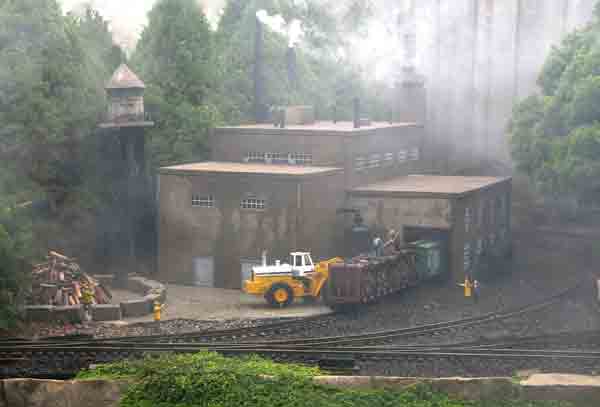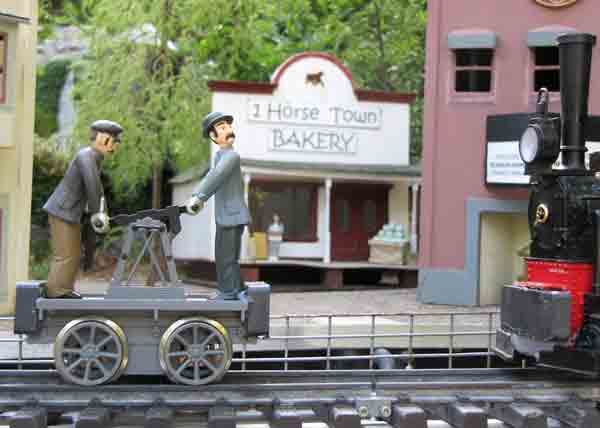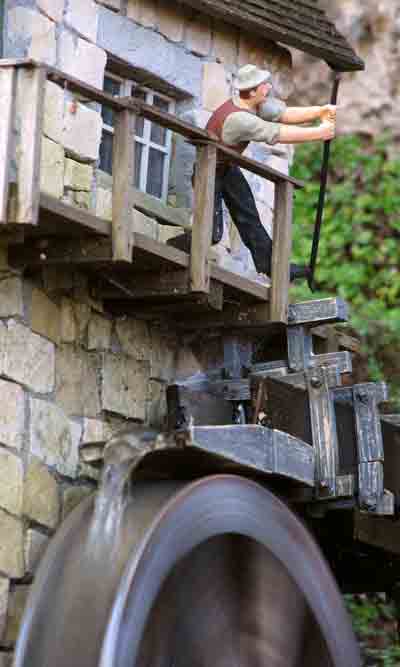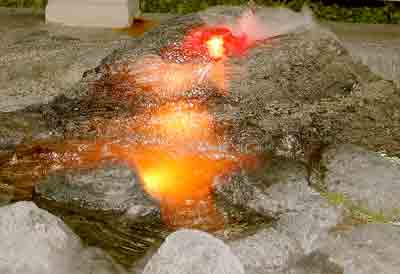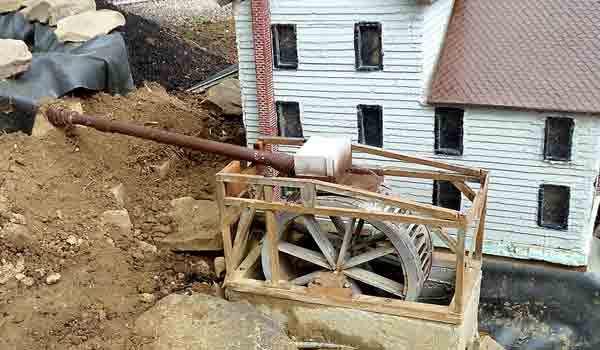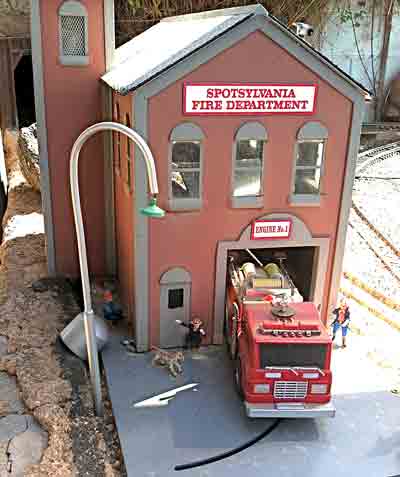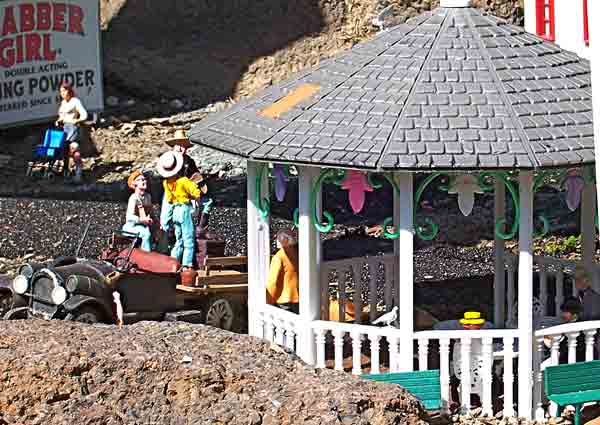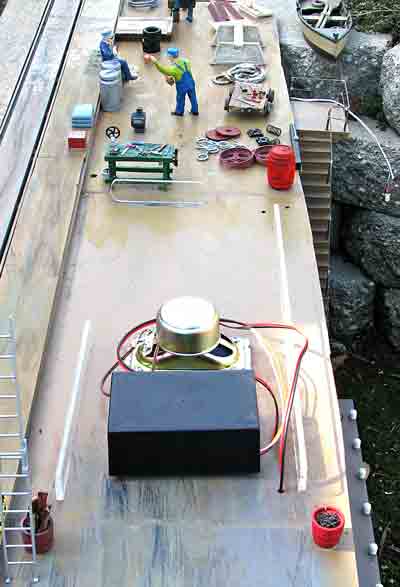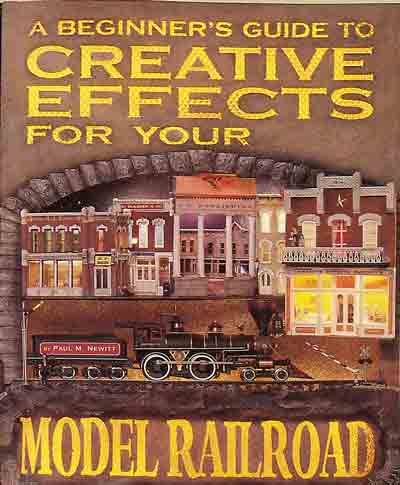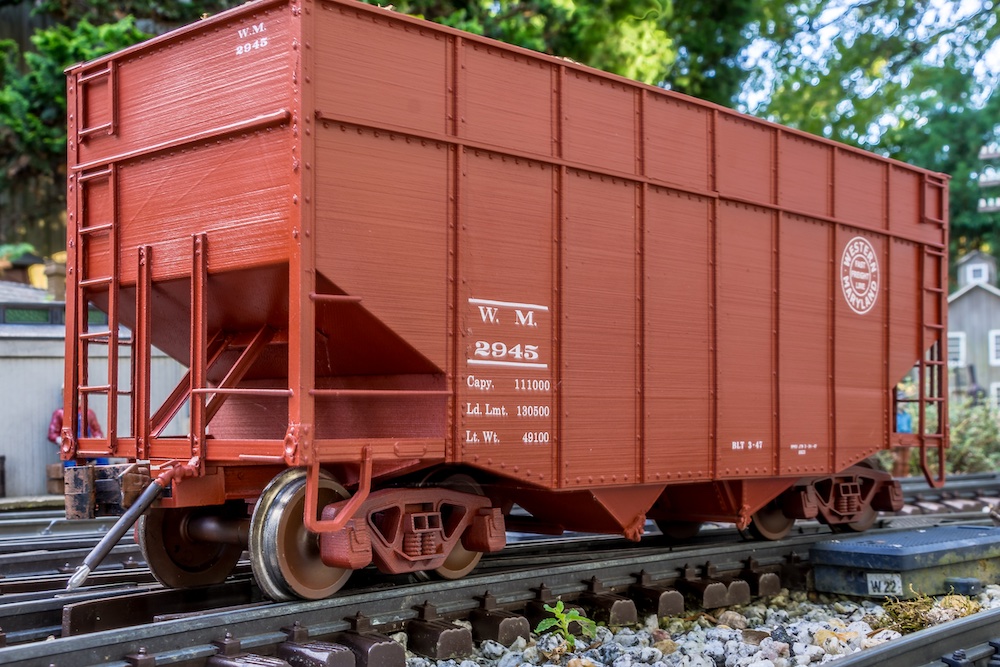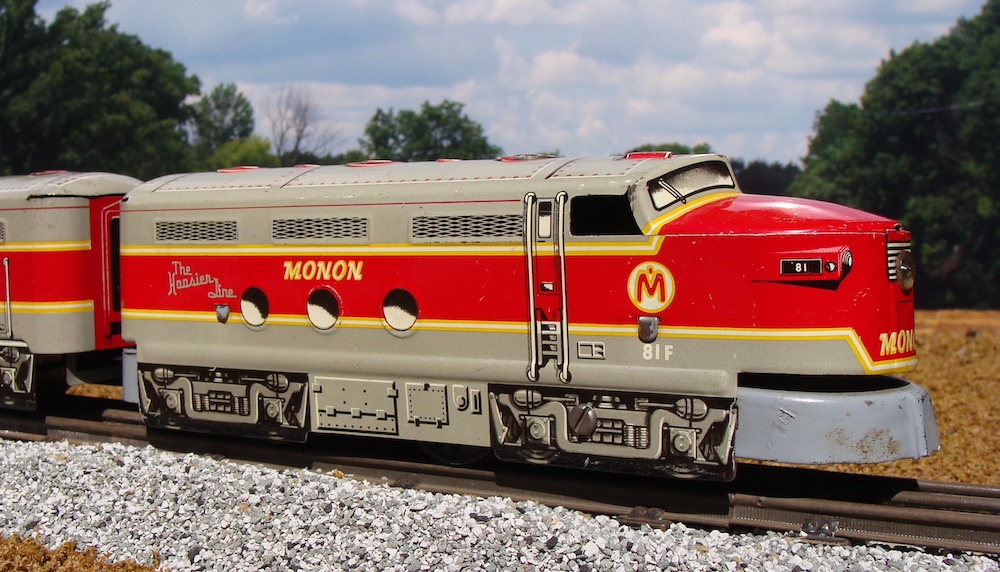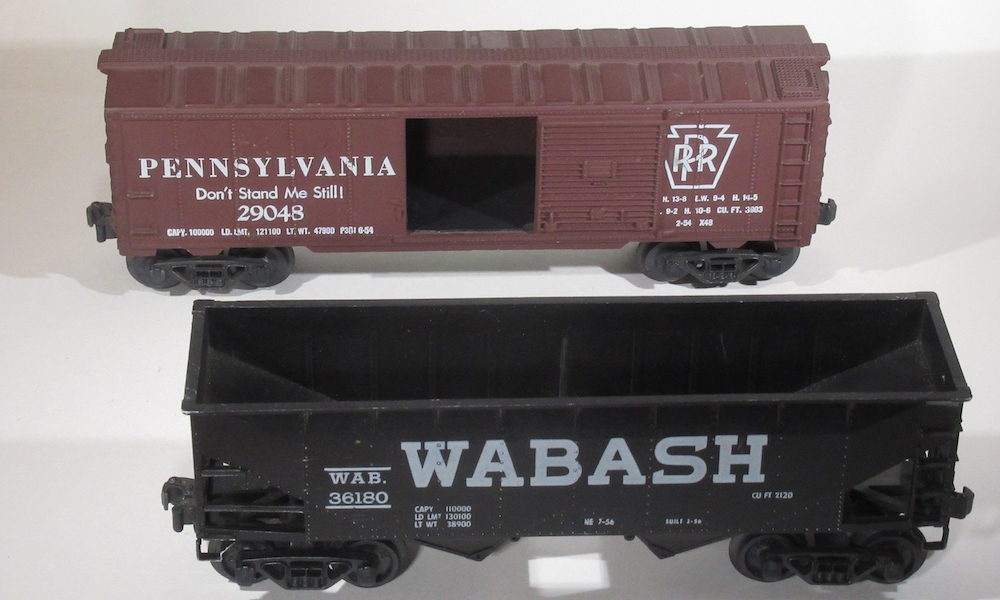If you look closely at animated cartoons, you’ll see that, at any one moment, only one item is moving—a hand, a mouth, a set of eyes—the point of focus. Viewers imagine the rest, filling in the blanks from our memory of how the world works, and cartoon producers keep production costs to a minimum.
In our gardens, animated scenes using mechanical and electrical parts must weather the dirt, wet stuff, blown-in debris, raging UV sun rays, freezing-expanding temperatures, twining tendrils, and creeping inhabitants. Garden railroaders must minimize production (and maintenance) costs too and, yet, we still find ingenious ways to make things move and shake after the train stops at the station. Here’s just a sampling.
Smoke, smog, and fog
Smoke units use little oil burners that heat up via an electrical connection to powered track or a low-voltage transformer. Why not wire your mini-cabin’s chimney to smoke with the aroma of bacon (www.megasteam.com)? Around Halloween, many stores sell smoke machines that run on 110V and cost between $50 and $200. Photo 1 shows how one of the oil burners makes a paper and power plant come to life. A stacked pile of wood and the logs being unloaded from the train show the source of some of that smoke, as well as a hint of the product: newsprint.
Also from the Halloween aisles, fan-blown “flame” machines cause red and yellow fabric fire to burn a blackened hollow of a house. Garden centers carry under-water units for water fogging, some of which come with lights.
Clockwork
Indoor clock-activated cuckoos won’t survive out in the weather, but a battery-powered analog clock is an easy install on the tower or face of a municipal building or church. Inexpensive electronic timers, whether plugged in to 110V or outdoor 12V transformers, can activate all sorts of momentary animations, as well as lights and water features. Better low-voltage transformers from irrigation-supply stores have several circuits for programming separate functions.
Steam sounds
I think I can, I think I can. Several companies advertising in this magazine offer digital sound boards that you can install in your locomotive to get the exact sound of the prototype. I’ve had a remote-controlled, live-steam whistle installed in my Accucraft Shay by Weltyk’s Whistles. You can hear my train on the installer’s website www.weltykswhistles.com. Live steam creates plenty of action but most of the animation around live steamers is watching guys running after their engines to manually turn down the throttle.
Low-tech turnstile
Live-steam operators are usually too busy filling and tweaking to care about animation scenes in the garden but perhaps you noticed the accidental animation in the “earth islands” video from my “. . .Benchwork” article, Feb. 2012: http://youtu.be/_9ashTZMVoo At 7:12-16 in the video, the beer fairy, who happens to be riding on the boxcar’s brake wheel of Jim Hadden’s beer train, spins around like a dervish by encountering an overhanging tree branch, an LOL (laugh out loud) moment. The concept was just an accident but why not use the force of the train to create more turnstile-like animation? It’s free!
Reverse polarity
Many railroaders have used magnets, installed between the ties, to switch on all sorts of animation and sounds when magnetically activated switches have been fastened under rolling stock, but Tony Cullen uses magnets to push his railtruck. The only motive power is a magnet disguised as the rear bumper. He attached a similar magnet with reversed polarity to the front of his locomotive. As the engine approaches, the opposite polarities of the magnets push the railtruck, which rolls ahead until the engine catches up. I copied Tony’s idea in photo 2. When running magnets on your railway, you’ll soon discover all the locations where steel bridges are too close to the train, creating “attractive” crashes!
Waterfalls have it all
Gurgling, whooshing, misting, and reflecting water invites birds to drink and us to watch. Adding a waterwheel that is actually powered by moving water is a bonus. Photo 3 shows the rushing water at the top of the wheel, but don’t underestimate the animation-enhancing stance of the worker, poised to open or shut the gates. Any strategically placed character calls attention to a scene or story, especially if the figure isn’t “posed” in a stiff, wooden stance. Viewing the art of arranged railway items is like overhearing a dialog between the artist and the objects.
Natural wind
Mount a little nylon flag (www.united-states-flag.com/smallhandflags.html) on a tall flagpole or hang a tire swing from a tree branch to catch a breeze. One of the hardest working animators of my garden is the little galvanized-steel windmill; and the windmill’s rotor head turns with a change in wind direction.
Strap a video camera onto your train on a windy day for the most life-like representation of your railway. In particular, the deciduous-tree leaves quiver on swaying branches, so be sure to include the broadleaf varieties in your plantings. You won’t see that modeled indoors.
Light and sound
Some of the most sustainable animation in garden railways is the simplest: a flashing LED (light emitting diode) coupled with a speaker and CD player or even a portable radio tucked into a church on Sunday morning, playing choir music. And here’s a website that will tell the electronically inclined how to combine the flash from a cheap camera with a sound source to create a mine explosion: www.trainelectronics.com/Animation_explosion/index.htm
Regional gardening reports
Zones listed are USDA Hardiness Zones
Question: Have you incorporated an alternate source of animation, movement, or sound in your garden, other than the trains?
Todd Brody
Santa Ana, California, Zone 10
Molten action
Our volcanoes are real “feather rocks,” drilled and hollowed out as necessary to accept tubes for water and wiring. The tubes were secured in the rock using cement, and the direct-burial wires were sealed in their tube using Plumber’s Goop. A pump located in the lake forces water into the cauldron from below and wires take care of the interior lighting and the ultrasonic misters used to produce the “steam and smoke.” Water cascades back to the lake over a series of waterfalls, behind which one of the trains pass. The misters run on 24V AC and consume about one amp each, so are safe for use in the garden (assuming you protect their power supplies). They can be obtained with different LED patterns and colors. In the case of the large volcano, an additional low-voltage light bulb is contained in an inverted jar that was first painted red inside. Wiring for this bulb is from a “flame module” that provides a nice, ever-changing glow. Finally, we mounted a waterproof light with a red filter underwater, below a rock, which shines up on the cascading water to give the illusion of a torrential, active eruption at night.
Gary Condry
Wooster, Ohio, Zone 6
Historic water works
My water wheel is a composite of wood, plastic, and metal. The basic form was a Stoneworks 8″ plastic water wheel. Redwood was used to make spokes and extend the wheel diameter to 9″ (18′ diameter in 12″ scale). The wheel was made with four curved sections, like a wagon wheel, connected to the spokes. The rims had slots cut into the inner side at the proper angle, where redwood slats were glued to make the buckets. A rod was used as an axle, inserted through a hollow brass tube to keep the wheel sides the proper distance apart. Each axle end was set in a plastic sleeve inside a wooden journal box, which was screwed to the redwood frame. Two ponds service the water feature: the lower one houses the pump that fills the upper pond, from which gravity feeds water from a black poly tube to the top of the waterwheel. I intend to plant thyme, making it look like a real pond with greenery up to the water line. I even made a cement drain-catch basin like the real one and modeled Kister’s white clapboard building. [See and hear Gary’s wheel in motion at www.youtube.com/watch?v=-bXs2V7m-BA&feature=channel. See his mill photos here: http://millpictures.com/mills.php?millid=1386]
Richard Friedman
California, Zone 9
Water, wind, wildlife
Probably the obvious one is water. I’ve got a pond with active fish in it (until the raccoons get hungry), and a waterfall with year-round sound, whether trains are running or not. That brings the railroad back to life when it would otherwise be sleeping. Then I added elephants squirting water into the pond. On the farm, a metal windmill adds some height to an otherwise flat part of the railroad but, if the wind is just right, I get the squeaking and creaking that I remember from my aunts’ and uncles’ farms throughout the Midwest.
Ray Turner
San Jose, California, Zone 9
FX galore
As a winter project one year, I decided to add several sound-effects units into my railroad. I already had a workshop with shop sounds and a mountain cabin with sounds of birds chirping. I added telegraphy sounds to one station when a train passes, and honky-tonk piano sounds to my saloon—also when a train passes. I had a gazebo and my wife bought me a set of bluegrass-musician figures one Christmas, so I added a speaker in the roof and set up a crowd outside watching the concert. I wanted music that would play sporadically, but for several hours without repeating. Having music constantly would be too much distraction and having it repeat while someone was enjoying an open house would be boring. I bought an inexpensive MP3 player and loaded it with bluegrass and folk music with 1-2 minutes of silence between songs. I can start it at the beginning of an open house session and it will play the whole day.
Frank Lucas
Pleasant Hill, California, Zone 9
Gee that sounds real
You can’t see it, but there is a little speaker taped to the underside of the roof of the gazebo (see photo above). The wires run to a cheap, battery-operated CD player at my control station, and they carry the bluegrass music I copied for the trio on the truck. This all makes sense when you realize that the setting for our “Orange Blossom Special” railroad is the Appalachian Mountains. For added realism, it doesn’t hurt that the Martinez (California) Amtrak station is less than five miles away. . .unbelievably life-like sounds!
Patience Hoag
Phoenix, Arizona, Zone 10
Loaded for bear
Our motto for the Wild Eagle Railroad is “Keep it interesting!” so there is a lot of movement and sound. One diorama shows a scene with a fisherman who has hooked a bear rather than a fish, and he’s pulling his line back and forth while we hear a recording of the fisherman telling the bear to let go! Because we have a large shade cloth covering the railroad, we are able to suspend a small hot-air balloon from the frame. It is wired so that, at night, it looks like its burners are firing off and on. Dan re-created his business (Eaglewings Ironcraft) on the railroad, complete with a welding shop and a welder who looks like he is actually welding, using a bright LED light and some creative electrical work. In the
middle of everything, an authentic (1:1) railroad crossbucks and wigwag signal, with flashing lights and bells, make the whole neighborhood think a train is coming (so we don’t use the bells much)!





